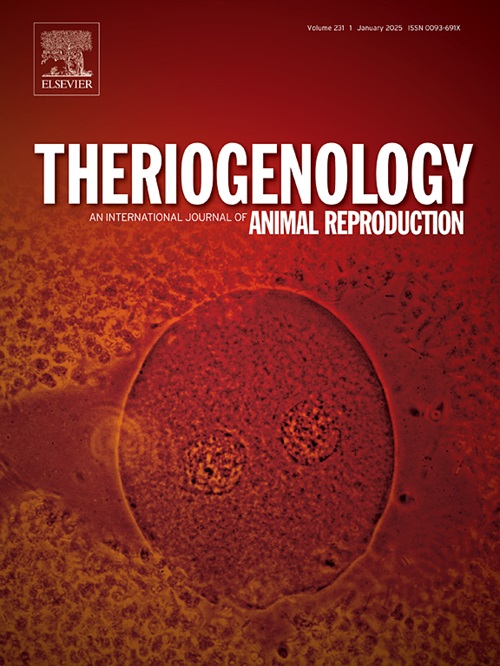使用辅助生殖技术出生的全生长母猪的代谢概况和血糖反应。
IF 2.4
2区 农林科学
Q3 REPRODUCTIVE BIOLOGY
引用次数: 0
摘要
本研究的目的是了解辅助生殖技术所产猪成年后的新陈代谢情况。饲喂约 4 小时后,从通过人工授精(AI 组,n = 7)和体外生产胚胎移植(IVP 组,n = 11)出生的 3.5 岁母猪身上采集血液样本,以测定碳水化合物(葡萄糖和乳酸盐)、蛋白质(白蛋白、肌酐和尿素)和脂类(胆固醇和甘油三酯)等主要生物标志物的生理浓度。四周后,在一夜禁食和停水 1 小时后进行口服葡萄糖耐量试验(OGTT;1.75 克葡萄糖/公斤体重)。在摄入葡萄糖前(T = 0 分钟;空腹条件)和摄入葡萄糖后 15、30、45、60、90、120、150、180、210 和 240 分钟采集血样。在每个时间点,立即使用血糖仪试纸测量血糖,并收集血清以测定上述代谢物以及胰岛素和胰高血糖素。OGTT 结束后,计算取样时间之间的曲线下面积(AUC)和胰岛素抵抗的稳态模型评估(HOMA)指数。在生理条件下,人工授精母猪和体外受精母猪的代谢物浓度相似。两组母猪的空腹胆固醇均降低,甘油三酯和尿素均升高(P<0.05)。本文章由计算机程序翻译,如有差异,请以英文原文为准。
Metabolic profile and glycemic response in fully-grown sows born using assisted reproductive technologies
The aim of the present work was to gain insight into the metabolism of pigs derived from assisted reproductive technologies during their adulthood. Approximately 4h after feeding, a blood sample was taken from 3.5 year old sows born by artificial insemination (AI group, n = 7) and transfer of in vitro produced embryos (IVP group, n = 11) to determine the physiological concentrations of the main biomarkers of carbohydrates (glucose and lactate), proteins (albumin, creatinine and urea) and lipids (cholesterol and triglycerides). Four weeks later, an oral glucose tolerance test (OGTT; 1.75g glucose/kg body weight) was performed after an overnight fast and 1h of water withdrawal. Blood samples were obtained prior (T = 0 min; fasting conditions) and 15, 30, 45, 60, 90, 120, 150, 180, 210 and 240 min after glucose intake. At each time point, glycemia was measured immediately using glucometer test strips, and serum was collected to determine the above metabolites along with insulin and glucagon. After OGTT, the area under the curve (AUC) between sampling times and homeostasis model assessment of insulin resistance (HOMA) indices were calculated. Under physiological conditions, the concentration of metabolites studied was similar between AI and IVP sows. In both groups, fasting decreased cholesterol and increased triglycerides and urea (P < 0.001). However, creatinine and lactate were similar in both groups under physiological and fasting conditions. The expected increase in albuminemia and decrease in glycaemia after fasting was only observed in IVP sows. OGTT revealed a different glucose curve pattern (monophasic in AI and biphasic in IVP group), a lower mean concentration of cholesterol, glucose, lactate, triglycerides in IVP compared to AI pigs (P < 0.01), and a higher mean concentration of albumin, creatinine and insulin in IVP compared to AI group (P < 0.05). On the contrary, no differences were found between groups for mean serum glucagon and urea levels, nor for glucose homeostasis indices HOMA-IR and HOMA-%B. The AUC differed between groups at several time points with larger AUC for creatinine, and smaller AUC for glucose, glucagon, and triglycerides, in IVP pigs than in AI pigs at 180–210 min (P < 0.05). In conclusion, under physiological conditions the metabolic profile of fully-grown AI and IVP sows is similar and within normal ranges. Glucose challenge revealed differences in metabolic and insulin responses between groups but with normal glucose tolerance in both cases.
求助全文
通过发布文献求助,成功后即可免费获取论文全文。
去求助
来源期刊

Theriogenology
农林科学-生殖生物学
CiteScore
5.50
自引率
14.30%
发文量
387
审稿时长
72 days
期刊介绍:
Theriogenology provides an international forum for researchers, clinicians, and industry professionals in animal reproductive biology. This acclaimed journal publishes articles on a wide range of topics in reproductive and developmental biology, of domestic mammal, avian, and aquatic species as well as wild species which are the object of veterinary care in research or conservation programs.
 求助内容:
求助内容: 应助结果提醒方式:
应助结果提醒方式:


